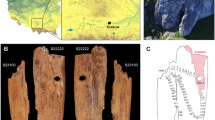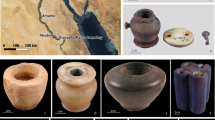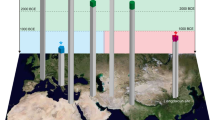This unguent shares some surprising features with modern moisturizing creams.
Abstract
The discovery of a small tin canister in London during archaeological excavations of a Roman temple precinct, dated to the middle of the second century AD1, is a landmark in the study of this class of artefact. Such discoveries from the Roman world are rare2 and this is the only one to be found so far with its lid and contents — a whitish medicinal or cosmetic cream — providing a unique opportunity for us to study the ancient formulation.
This is a preview of subscription content, access via your institution
Access options
Subscribe to this journal
Receive 51 print issues and online access
$199.00 per year
only $3.90 per issue
Buy this article
- Purchase on Springer Link
- Instant access to full article PDF
Prices may be subject to local taxes which are calculated during checkout


Similar content being viewed by others
References
Durrani, N. Curr. Archaeol. 192, 540–547 (2004).
Beagrie, N. Britannia 20, 169–191 (1989).
Copley, M. S. et al. Proc. Natl Acad. Sci. USA 100, 1524–1529 (2003).
Ralph, J. & Hatfield, R. D. J. Agric. Food Chem. 39, 1426–1437 (1991).
Blakeney, A. B., Harris, P. J., Henry, R. J. & Stone, B. A. Carbohyd. Res. 113, 291–299 (1983).
PDF-2 Powder Diffraction Database (International Centre for Diffraction Data, Pennsylvania, 1999).
Cert, A., Lanzón, A., Carelli, A. A., Albi, T. & Amelitti, G. Food Chem. 49, 287–293 (1994).
Pliny Natural History (ed. Rackham, H.) 9 (Loeb Classical Library, Cambridge, Massachusetts, 1944).
Riddle, J. M. in Dioscorides on Pharmacy and Medicine 153–154 (Univ. of Texas Press, 1985).
Toxicological Profile for Tin and Tin Compounds (Agency for Toxic Substances and Disease Registry, US Public Health Service, 2003).
Author information
Authors and Affiliations
Corresponding author
Ethics declarations
Competing interests
The authors declare no competing financial interests.
Rights and permissions
About this article
Cite this article
Evershed, R., Berstan, R., Grew, F. et al. Formulation of a Roman cosmetic. Nature 432, 35–36 (2004). https://doi.org/10.1038/432035a
Published:
Issue Date:
DOI: https://doi.org/10.1038/432035a
This article is cited by
-
Infrared spectroscopy reveals the reactivity of fatty acids on copper surfaces and its implications for cultural heritage objects
Heritage Science (2023)
-
Analysis of fingerprints on a PPNB figurine from the Tell Halula site, Syria
Archaeological and Anthropological Sciences (2023)
-
Not only wall paintings—pigments for cosmetics
Archaeological and Anthropological Sciences (2021)
-
Analytical Approaches Based on Gas Chromatography Mass Spectrometry (GC/MS) to Study Organic Materials in Artworks and Archaeological Objects
Topics in Current Chemistry (2016)
-
HPLC–APCI-MS analysis of triacylglycerols (TAGs) in historical pharmaceutical ointments from the eighteenth century
Analytical and Bioanalytical Chemistry (2011)
Comments
By submitting a comment you agree to abide by our Terms and Community Guidelines. If you find something abusive or that does not comply with our terms or guidelines please flag it as inappropriate.



